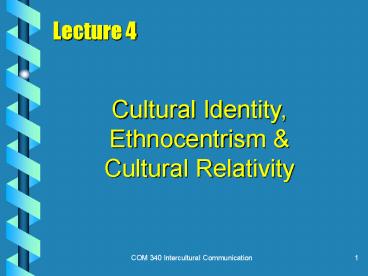Cultural Identity, - PowerPoint PPT Presentation
1 / 14
Title:
Cultural Identity,
Description:
Anthropologists tell us there are only three true 'races' ... Reinforces distance between their group and other groups, and lessens the chance of interaction. ... – PowerPoint PPT presentation
Number of Views:3295
Avg rating:3.0/5.0
Title: Cultural Identity,
1
Lecture 4
Cultural Identity, Ethnocentrism Cultural
Relativity
2
Race Ethnicity
- Anthropologists tell us there are only three true
races of people in the world. - Caucasoid
- Negroid
- Mongoloid
- However, there are thousands of ethnic groups.
- These groups have a particular identity.
- Share similar features in language, clothing,
food, music, etc. AND - Share similar physical features, such as in hair,
face, and body types.
3
Cultural Identity
- The ethnic group(s) to which we belong help us to
be aware of who we are and of our connections
with others. The make up our cultural identity. - Members of every culture have a sense of social
identification. - Who they are and why.
- Our cultural identity also affects our
inter-personal relationships and expectations.
4
Cultural Identity (cont)
- From a sense of social identity (who we are),
one receives a sense of personal identity (who
I am). - This is particularly true for cultures that are
collectivist (group oriented) in nature as
opposed to individualistic in nature. - The cultural groups we belong to help give
continuity and a sense of belonging to our lives. - But, at the same time these cultural groups
help to divide people in a negative way.
5
Ethnocentrism
- While it is important to know our own cultural
identity and what makes us the person we are, we
must constantly remember that our own culture is
not the only culture in the world. - Ethnocentrism Seeing our own culture as the
center of everything and evaluating everything
according to our own groups values.
6
Ethnocentrism (cont)
- Leads to viewing
- Our groups way Other groups ways
- Superior
Inferior - Normal Abnormal
- Right
Wrong - Real
Unreal
7
Ethnocentrism (cont)
- While natural to judge according to our own
cultural standards, this also hinders our
understanding of other cultures and their
patterns of communication. - A high level of ethnocentrism leads to
misperception of members of other groups. - Can cause us to make inaccurate interpretations
about their actions.
8
Culture Relativism
- Opposite of Ethnocentrism
- Idea that all cultures are of equal value, and
the values and behavior of the people of a
certain culture can only be judged using that
culture as a basis for judgement.
9
Ethnocentrism -Cultural RelativismContinuum
Moderate Cultural Relativism
Low Ethnocen- trism Low Cultural Relativism
High Cultural Relativism
Moderate Ethnocen- trism
Low Ethnocen- trism
10
High Ethnocentrism
- Shows an indifference and insensitivity to
foreigners. - Characterized by use of foreigner talk when
speaking to someone whose native language is
different than ones own. - Speaks louder and slower than usual
- Exaggerates pronunciation
- Simplifies the language (removes articles and
uses simple verb tenses)
11
Moderate Ethnocentrism
- Attempts to avoid or minimize contact with
members of an out-group. - Reinforces distance between their group and other
groups, and lessens the chance of interaction. - Characterized by intentional use of
in-group dialect.
12
Low Ethnocentrism Low Cultural Relativism
- A state of feeling in competition with another
group for the same resources. - Characterized by use of pejorative expressions
and nicknames for certain groups also ethnic
jokes.
13
Moderate Cultural Relativism
- Reflects a sensitivity to cultural differences.
- Characterized by speech that reflects a desire to
decrease the communicative distance between ones
group and members of the other group.
14
High Cultural Relativism
- Shows desire to minimize distance between oneself
and members of the out-group. - Requires an attitude of equality.
- When interpreting the behavior of the members of
the out-group, does so by using the values of
their culture.































